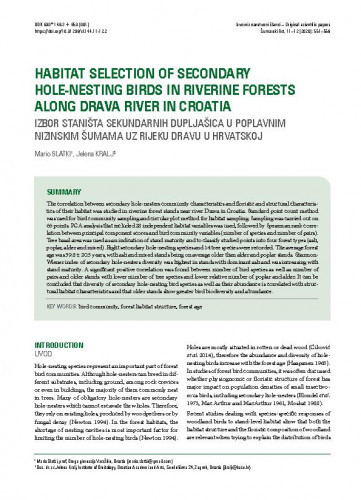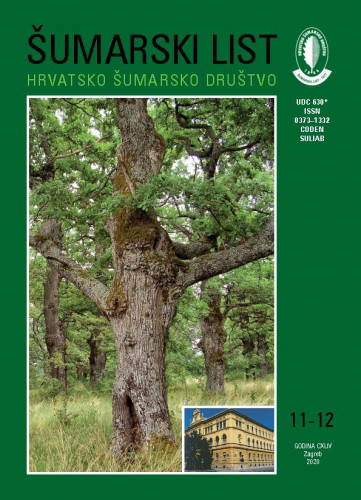The correlation between secondary hole-nesters community characteristics and floristic and structural characteristics of their habitat was studied in riverine forest stands near river Drava in Croatia. Standard point count method was used for bird community sampling and circular plot method for habitat sampling. Sampling was carried out on 66 points. PCA analysis that included 28 independent habitat variables was used, followed by Spearman rank correlation between principal component scores and bird community variables (number of species and number of pairs). Tree basal area was used as an indication of stand maturity and to classify studied points into four forest types (ash, poplar, alder and mixed). Eight secondary hole-nesting species and 14 tree species were recorded. The average forest age was 59.8 ± 20.5 years, with ash and mixed stands being on average older than alder and poplar stands. Shannon-Wiener index of secondary hole-nesters diversity was highest in stands with dominant ash and was increasing with stand maturity. A significant positive correlation was found between number of bird species as well as number of pairs and older stands with lower number of tree species and lower relative number of poplar and alder. It can be concluded that diversity of secondary hole-nesting bird species as well as their abundance is correlated with structural habitat characteristics and that older stands show greater bird biodiversity and abundance.; Korelacija između karakteristika zajednica sekundarnih dupljašica te florističkih i strukturalnih karakteristika staništa istražena je u nizinskim poplavnim šumama uz rijeku Dravu u Hrvatskoj. Standardna metoda prebrojavanja u točki korištena je za istraživanje zajednica ptica, a metoda kružnih ploha za istraživanje staništa. Mjerenja su provedena na ukupno 66 točaka. Korištena je analiza primarnih komponenti sa 28 varijabli staništa te Spearman rank korelacija između skorova primarnih komponenti i varijabli zajednica ptica (broj vrsta i broj parova). Bazalna površina stabala korištena je kao indikator starosti, ali i za klasifikaciju istraživanih točaka u četiri skupine (sastojine jasena, topole, johe i miješane sastojine). Zabilježeno je ukupno osam vrsta sekundarnih dupljašica i 14 vrsta drveća. Prosječna starost istraživanih točaka bila je 59,8 ± 20,5 godina. Sastojine jasena i miješane sastojine u prosjeku su bile starije od sastojina johe i topole. Shannon-Wiener indeks raznolikosti bio je veći u sastojinama s dominantnim jasenom i povećavao se sa starosti šume. Značajna pozitivna korelacija dobivena je između broja vrsta te brojnosti ptica i starijih sastojina s manjim brojem vrsta drveća i manjim relativnim brojem jedinki topole i johe. Možemo zaključiti da sastav zajednica sekundarnih dupljašica u nizinskim poplavnim šumama ovisi o strukturnim karakteristikama šuma, pri čemu stare sastojine pokazuju veću brojnost i raznolikost.
Sažetak

 Šumarski list : znanstveno-stručno i staleško glasilo Hrvatskoga šumarskog društva = journal of the Forestry Society of Croatia = Zeitschrift des Kroatischen Forstvereins = revue de la Societe forestiere Croate : 144, 11/12(2020) / glavni urednik Josip Margaletić.
Šumarski list : znanstveno-stručno i staleško glasilo Hrvatskoga šumarskog društva = journal of the Forestry Society of Croatia = Zeitschrift des Kroatischen Forstvereins = revue de la Societe forestiere Croate : 144, 11/12(2020) / glavni urednik Josip Margaletić.